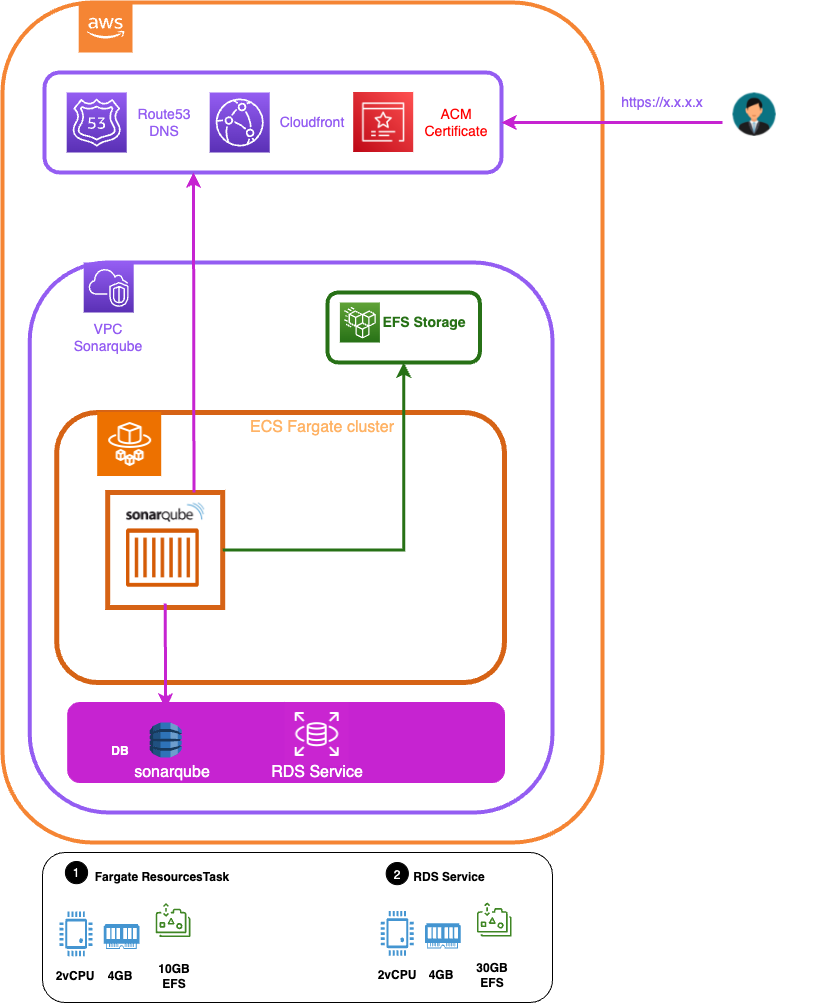Deployment of SonarQube on AWS ECS Fargate
AWS Elastic Container Service (ECS) Fargate is a serverless compute engine designed for running containerized applications. It simplifies the deployment and management of containers without the need to provision or manage underlying infrastructure.
Are you looking for a streamlined way to deploy SonarQube on AWS ECS Fargate? Look no further! In this post, we’ll guide you through the steps to make this process easy and efficient, while highlighting the numerous benefits of this solution.

-
Step 1: Set Up Your AWS Environment Start by creating an AWS account if you don’t already have one. Then, set up an Elastic Container Registry (ECR) to store your SonarQube Docker image or using a offical sonarqube docker image. This will ensure your application is readily available for deployment.Configure the necessary VPC, subnets, and security groups for your ECS Fargate service.
-
Step 2: Set up Your AWS RDS PostgreSQL database Create a secret RDS DB instance,create a secret for sonarqube database, deploy AWS RDS PostgreSQL instance and create sonarqube database.
-
Step 3: Create a AWS ECS Fargate cluster
-
Step 4: Deploy SonarQube Create an ECS task definition, specifying the SonarQube image from your repository. Ensure you allocate the appropriate CPU and memory resources according to your requirements.
For example, for a 1M LOC you’ll need the following resources:
vCPU : 2 - Memory : 4GB - Storage: 10GB
Provision persistent storage (EFS)
Provision an ip public address
Now, let’s dive into the benefits of this solution:
-
Scalability: ECS Fargate allows for easy scaling of your SonarQube instance. You can adjust resources based on workload and traffic demands, ensuring optimal performance without overprovisioning.
-
Cost Efficiency: Fargate’s serverless architecture eliminates the need to manage underlying infrastructure. You only pay for the resources you consume, making it a cost-effective choice.
-
Simplified Management: AWS ECS Fargate abstracts many administrative tasks, reducing the operational overhead associated with traditional infrastructure management.
-
High Availability: By distributing containers across multiple Availability Zones, you ensure high availability and fault tolerance for your SonarQube instance.
-
Security: AWS provides robust security features, including VPC isolation, IAM roles, and encryption options, to protect your SonarQube deployment.
-
Integration: Easily integrate SonarQube with other AWS services like Amazon RDS, S3, and CloudWatch for comprehensive monitoring, data storage, and management capabilities.
-
Automatic Updates: With containerized deployments, it’s simple to update SonarQube to the latest version without the complexity of traditional upgrades.
If you want to get hands-on, follow this link on github it describes the different steps of deployment using AWS CDK for golang.
 Conclusion
Conclusion
FBy following these steps and leveraging AWS ECS Fargate for SonarQube deployment, you’ll have a robust, scalable, and cost-effective solution that enhances the quality of your code and streamlines the development process.
So, if you’re ready to boost your code quality while simplifying deployment, give AWS ECS Fargate and SonarQube a try!
 Resources
Resources